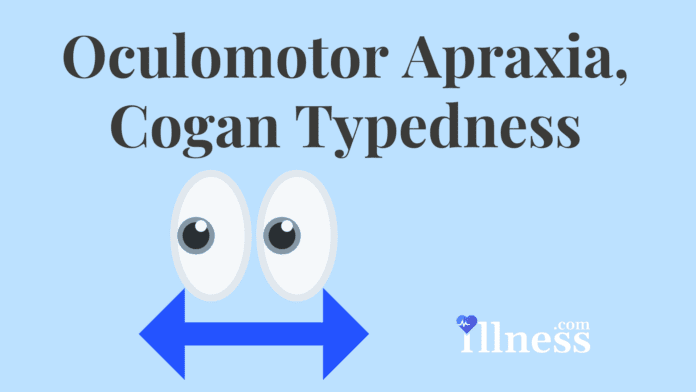Overview Of Adult Onset Ataxia With Oculomotor Apraxia
Adult onset ataxia with oculomotor apraxia is a neurological disorder involving movement difficulties that worsen with time. Ataxia (poor balance and coordination) is the hallmark symptom of this disorder. In many cases it is also the first symptom. Oculomotor apraxia makes it difficult for affected people to move their eyes horizontally (side-to-side). Those with this disorder need to turn their heads to have proper peripheral vision (the ability to see things in the far edges of the eyes).
Nearly all forms of ataxia with oculomotor apraxia involve the affected person developing nerve abnormalities known as neuropathy. Neuropathy reduces the person’s reflexes and can lead to an inability to sense vibrations and overall weakness of the limbs. A lot of people with the disorder end up needing to use a wheelchair for mobility, and most often around 10-15 years after their movement difficulties began.
Some types of ataxia with oculomotor apraxia may have blood abnormalities that can differ by which type of the disorder they have.
Most people who have ataxia with oculomotor apraxia do not have any intellectual effects from their disorder, but in some uncommon cases, intellectual disability can occur.
Types Of Adult Onset Ataxia With Oculomotor Apraxia
There are several types of ataxia with oculomotor apraxia. The most common types are 1,2, and 4. Each disorder type has similar symptoms, but involves different mutated genes.
- Type 1 of this disorder typically develops around age 4, and affected people can experience muscle twitches (called myoclonus) and involuntary jerking movements (called chorea). These muscle movement difficulties most often disappear with time. Those with the disorder also develop neuropathy, which along with the development of muscular wasting in the hands and feet can really interfere with their mobility. When it comes to characteristic blood abnormalities, individuals with type 1 have reduced amounts of the protein albumin. This shortage can result in elevated levels of cholesterol in the bloodstream. This increased cholesterol can increase the person’s risk for developing heart disease.
- Type 2 ataxia with oculomotor apraxia usually develops around age 15, and affected people may also experience myoclonus or chorea. Unlike type 1, however, these movement issues do not disappear with time, and typically persist throughout their lifespan. Neuropathy is common for this type of the disorder. Those with type 2 do not tend to have elevated levels of albumin in their bloodstream. They do have high levels of the protein alpha-fetoprotein (AFP) in their blood. They may also have high levels of the protein creatine phosphokinase (CPK).
- Type 4 also begins around age 4, but they have an additional symptom called dystonia. Dystonia involves an involuntary sustained tensing of the muscles that causes the body to position itself into unusual poses. Dystonia can be the first seen symptom of type 4, and it often disappears gradually. Neuropathy and muscle wasting are also common in this subtype. In the bloodstream, albumin levels can be low, but are often normal in many cases.
Commonly Associated With
SCAR1, Spinocerebellar ataxia recessive non-Friedreich type 1, Early-onset ataxia with ocular motor apraxia and hypoalbuminemia, SCAN2, EAOH, Spinocerebellar ataxia with axonal neuropathy type 2
Causes Of Adult Onset Ataxia With Oculomotor Apraxia
Ataxia with oculomotor apraxia occurs due to a mutation in a specific gene. The affected gene depends on the type of the disorder. Typically affected genes include the APTX, PNKP, or SETX genes, among others.
The three mentioned genes usually function by providing the necessary instructions for protein production. These proteins repair damaged DNA. When these genes are damaged or mutated in some way, there aren’t enough of the proteins needed to repair DNA. This can lead to an accumulation of damaged and broken strands of DNA.
Unrepaired DNA damage can lead to cell death, as unrepaired damage destabilizes cells and their functions. Cell death is especially bad in the brain, as the nervous system can’t replace lost nerve cells. The cerebellum is especially at risk for this type of cell loss. Given that the cerebellum normally functions to coordinate a person’s movements, it makes sense that a lot of the characteristic symptoms of ataxia with oculomotor apraxia include movement issues.
Other
Ataxia with oculomotor apraxia is considered a rare disorder. Different areas of the world have varying rates of each type of the disorder. Types 1 and 4 are found most often in Portugal, and type 1 can be found in Japan. Type 2 is rare enough that it is thought to only occur in 1 out of every 900,000 people worldwide. Type 3 is even rarer still, and has only been found in one particular family so far.
All types of the disorder are autosomal recessive when inherited. This means that each parent has to have a defective copy of the particular gene involved in the disorder, and their child inherits two defective copies. If only one parent had a defective copy of the gene, the disorder would not occur in any of their children. Parents with only one copy of the gene do not suffer from the condition themselves, as they need two copies for that to happen.



